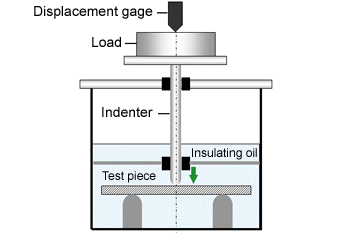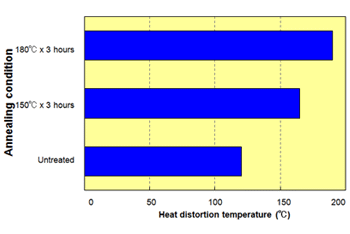- HOME
- Technical Information
- TORELINA™ PPS Resin
- Various Properties
- Thermal Properties
- Heat Distortion Temperature
Heat Distortion Temperature
 Fig. 6.4 Heat distortion temperature test method
Fig. 6.4 Heat distortion temperature test method
The heat distortion temperature is one heat resistance index, and is an index of the strength (elastic modulus) of a material at high temperature. The test method is a 3-point bending method, similar to the flexural test. For the flexural modulus, the breaking load is determined at a constant strain rate. In contrast, for the heat distortion temperature, the temperature at which a specified amount of displacement is reached is determined by gradually heating (120℃/hr)in a state in which a constant load (according to ISO 72, the low load is 0.45 MPa and the high load is 1.80 MPa) is applied. (Fig. 6.4) If the cross-section of a molded product is rectangular, as in the case of the ISO test piece, the method whereby pressure is applied to the long side (10 mm) with an indenter is called the flatwise method, whereas the method whereby pressure is applied to the short side (4 mm) is called the edgewise method. For the heat distortion temperature of TORELINA™, measurements obtained with the flatwise method are shown.
 Fig. 6.5 Annealing treatment in relation to heat distortion temperature
Fig. 6.5 Annealing treatment in relation to heat distortion temperature
In general, the heat distortion temperature is a property correlated to the temperature dependence of the flexural modulus. The reinforced PPS of TORELINA™ maintains its high elastic modulus even in a high-temperature environment, and it has high heat resistance of 260℃ or greater even under high load conditions. (Table. 6.1) On the other hand, the unreinforced PPS grades of TORELINA™, A900 and A670T05, show a heat distortion temperature near the glass transition temperature, at which increases in the elastic modulus become large. For this reason, if unreinforced PPS is to be used for applications that require strength at high temperatures, a technique for increasing the degree of crystallinity with annealing treatment should be applied. (Fig. 6.5)
Table. 6.1 Heat distortion temperature of TORELINA™
| Item | Load conditions |
Units | Glass fiber reinforced | Glass + filler reinforced | Elastomer improvement | Unreinforced | |||||
|---|---|---|---|---|---|---|---|---|---|---|---|
| A504X90 | A604 | A310MX04 | A610MX03 | A673M | A575W20 | A495MA2B | A900 | A670T05 | |||
| Heat distortion temperature |
0.45MPa | ℃ | >260 | >260 | >260 | >260 | >260 | >260 | >260 | 132 | 120 |
| 1.8MPa | >260 | >260 | >260 | >260 | >255 | >260 | >260 | 105 | 100 | ||